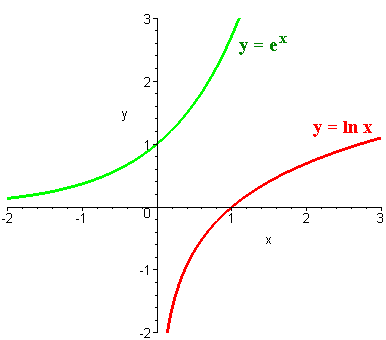LOGARITHMS
The inverse of the exponential function-- The Natural Logarithm
The graph of
y = ex
clearly shows that it is a one to one function, hence an inverse exists. We call this inverse the natural logarithm. and write it as
y = ln x
Below is the graph of
y = ex
and
y = ln x
By definition, they are reflections of each other across the line y = x.

Inverse Properties of Logs
Since logs and exponents cancel each other we have:
eln x = x
and
ln ex = x
Example
eln 3 = 3 and ln(e5) = 5
Three Properties of Logs
Property 1: ln (uv) = ln u + ln v (The Product to Sum Rule)
Property 2: ln (u/v) = ln u - ln v (The Quotient to Difference Rule)
Property 3: ln ur = r ln u (The Power Rule)
Example:
Expand:
ln (xy2/z)
by property 2 we have:
ln (xy2) - ln z
by property 1 we have
ln x + ln y2 - ln z
By property 3 we have
ln x + 2 ln y - ln z
Exercise
Try to expand
![]()
![]()
Example
Write as a single logarithm:
4ln x - 1/2ln y + ln z
Solution
We first use property 3 to write:
ln x4 - ln y1/2 + ln z
Now we use property 2:
x4
ln
+ ln z
y1/2
Finally, we use property 3:
x4 z
ln
+ ln z
y1/2
Exercise
Write the following as a single logarithm:
1/3 ln x + 2 ln y - 3 ln z
![]()
Example
Suppose that
ln 3 = 1.10
and that
ln 5 = 1.61
Find
ln 45
Solution
Since
45 = (5)(32)
We have
ln 45 = ln (5)(32) = ln 5 + ln 32
= 1.61 + 2 ln 3
= 1.61 + 2 (1.10) = 3.81
Exponential Equations
The key to solving equations is to know how to apply the inverse of a function. When we have an exponential equation, we will use the natural logarithm to cancel the exponential.
Example
Find k if
34 = e10k
Solution
Take the natural logarithm of both sides
ln 34 = ln e10k
Now use the inverse property
ln 34 = 10k
Finally divide by 10
ln 34
= k = 0.3526
10
Carbon Dating
All living beings have a certain amount of radioactive carbon C14 in their bodies. When the being dies the C14 slowly decays with a half life of about 5600 years. Suppose a skeleton is found in Tahoe that has 42% of the original C14. When did the person die?
Solution
We can use the exponential decay equation:
y = Cekt
After 5600 years there is
C/2
C14 left. Substituting, we
get:
C/2 = Cek(5600)
Dividing by C,
1/2 = e5600k
Take ln of both sides,
ln(0.5) = 5600k
so that
ln(0.5)
k =
= -0.000124
5600
The equation becomes
y = Ce-0.000124t
To find out when the person died, substitute
y =
0.42C
and solve for t:
0.42C = Ce-0.000124t
Divide by C,
0.42 = e-0.000124t
Take ln of both sides,
ln(0.42) = -0.000124t
Divide by -0.000124
ln(0.42)
t =
= 6995
-0.000124
The person died about 7,000 years ago.
Back to the Math 116 Home Page
Back to the Math Department Home
e-mail Questions and Suggestions